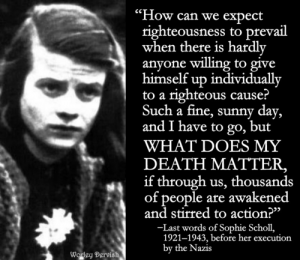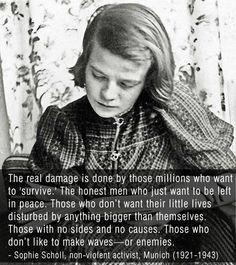Posted by Jen E on Friday, Mar 31, 2017
 This morning a crowd of very excited middle schoolers from a local school bounded up to the second floor of the library to do research. Having other excited researchers flooding up the quiet, second floor stairs buoys the heart of a librarian like nothing else. I spoke with their teacher about the project they were working on. The students wanted to know how media played a role in the resistance movements against the Nazi party in WWII.
This morning a crowd of very excited middle schoolers from a local school bounded up to the second floor of the library to do research. Having other excited researchers flooding up the quiet, second floor stairs buoys the heart of a librarian like nothing else. I spoke with their teacher about the project they were working on. The students wanted to know how media played a role in the resistance movements against the Nazi party in WWII.
The group of girls I talked to were going to put on a play about the White Rose Movement. I had never heard about this movement before or Hans and Sophie Scholl. Before even coming up to the desk, the girls had basically cleaned the library out of all obvious available books and DVDs we had on the subject, so, my challenge was to see what else I could find about the group to point them to.
I did some basic research using Wikipedia to kind of get me started. The White Rose movement was a leaflet and graffiti campaign that was headed by Munich University students Hans Scholl and Sophie Scholl, Alexander Schmorell, Willi Graf, and professor, Christoph Probst. Hans and Sophie were the first of the group to be tried by the People's Court for distributing propaganda materials decryin
 g the Nazi regime. The two were beheaded on February 22, 1943 for treason. One of the pamphlets written by the group was smuggled out of the country, printed by the Allied forces, and dropped over German cities. Before their deaths the group had distributed close to 15,000 leaflets.
g the Nazi regime. The two were beheaded on February 22, 1943 for treason. One of the pamphlets written by the group was smuggled out of the country, printed by the Allied forces, and dropped over German cities. Before their deaths the group had distributed close to 15,000 leaflets.
Within our collection's access, I was able to find a burial record in Ancestry.com for Sophie Scholl which shows the memorial and the headstones marking her burial plot. I found a newspaper article in the New York Times written in 1947 about how German schools were using Sophie Scholl's heroism to revive the broken spirits of school children. There was a thorough article in the History Review about the White Rose movement and how it compared with other more affluent and organized political groups opposing the Nazis. And finally there was a small article publishing the song lyrics that were believed to be the inspiration for the movement's name.
I'm always surprised by the breadth of the materials we have access to through our databases. There were more full text articles beyond those I've listed above. If you're doing some research either for your own knowledge or for a school project see what you can find or ask one of us at the Info Desk to help you! Needless to say after helping these girls research this topic, I became fascinated with Sophie Scholl myself. I've already put holds on some of the books the girls had checked out in our collection. You can check them out as well:




